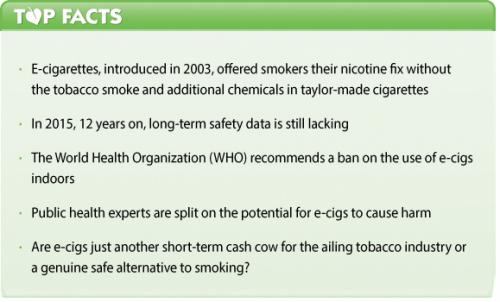Content Sections
An uncontrolled experiment with consumers?
Electronic cigarettes (e-cigs) are everywhere right now. Hyped up as trendy, must-have alternatives to regular cigarettes and billed as the ‘healthy’, ‘safer’ alternative. However, are they a brilliant solution to one of the most dangerous and addictive habits affecting the world’s estimated one billion smokers, or just another, albeit different, fast track to disease?

Described by the German Cancer Research Center, Heildelberg as “An uncontrolled experiment with Consumers”, the odourless vaporisers were introduced in 2003 by a Chinese pharmacist and smoker, Han Lik, following the death of his father from lung cancer. Lik figured this could be revolutionary; a relatively inexpensive way in which smokers could still get their nicotine fix without the lung-damaging smoke, tobacco, and some 200 odd chemicals that are routinely added in the production of taylor-made cigarettes. Fast forward to 2015 and there are now over 450 brands of e-cigs in thousands of flavours. They’re literally trending! But as trendy as they might be, how much of a public health risk do they pose given the lack of published long-term health data for users and passive users?
In their explanation, Public Health England states that, “Electronic cigarettes offer nicotine delivery in a format that mimics smoking, have a socially acceptable non-medical image which enables users to retain their smoker identity but without the risk of smoke, are relatively inexpensive (start-up costs can be high, but running costs much lower than smoking), and despite (to date) nicotine delivery that is low relative to cigarettes, have proved popular with the current minority of smokers who use them.”
Toxic vapours and passive exposure
E-cigs (vaporisers) are typically used as a cessation aid or an alternative to the standard cigarette, with many believing them to be a healthier alternative. In our view, their benefits are uncertain, as is their safety. The German Cancer Research Center, Heildelberg says that, similar to regular cigarettes, second-hand exposure to e-cigarette emissions may lead to adverse health effects and such risks cannot be excluded. Their use is almost entirely restricted to young people who are already smoking, or have already smoked tobacco and, while many places banned regular smoking indoors in 2007, the use of e-cigs is permitted in enclosed public spaces.
This permission may not last though as tensions are building up in offices where co-workers are exposed to passive e-cig vapours. Wales wants to ban ‘vaping’ inside in line with the World Health Organization’s (WHO) recommendation to ban the use of e-cigs indoors. The WHO also warns that advertisements could encourage children and non-smokers to use the devices, and agrees with the German Cancer Research Center that exhaled e-cigarette vapour could increase the background air levels of some toxicants and nicotine.
A report commissioned by Public Health England reveals that the principal component other than nicotine, usually propylene glycol, is not known to have adverse effects on the lung, but they also warn that to their knowledge there has been no testing in “models that approximate the repeated inhalation, sustained over many years, that electronic cigarettes involve.” Other ingredients include flavours (tobacco flavour, fruit flavours, chocolate, menthol, rum, coca cola, piña colada, ice cream, candy floss and many others) and, as a rule, nicotine; but there are also nicotine-free liquids. A study carried out by the German Cancer Research Center shows that some e-cigs have been found to contains small amounts of nitrosamines, formaldehyde, acetaldehyde and acrolein, classified as known or probable carcinogens by the International Agency for Research on Cancer. Since no dosage threshold for safety is established for carcinogens, there is a definite risk that e-cigs may be cancer-causing both to their consumers and those exposed to second-hand vapour.
The same study also demonstrated that although the ultrafine particles produced by e-cigs are substantially fewer than from conventional cigarettes, second-hand exposure by non-users has increased because they are permitted indoors in many venues, in many countries. That may change, however, as the science accumulates.
Divided opinion
Professor of public health and policy at Liverpool University's Institute of Psychology, Health and Society, Simon Capewell, argues that e-cigarettes help to “glamorise and renormalise smoking”. Although many agree with him, overall the public health community is divided on this topic. A study published by the National Center for Biotechnology Information concludes, “ECs [Electronic Cigarettes] represent a historical opportunity to save millions of lives and significantly reduce the burden of smoking-related diseases worldwide.” The study does concede to the fact that some residual risks may be present with e-cig use and “some toxic chemicals are released in the EC vapor” but adds that their “levels are substantially lower compared with tobacco smoke.” So basically they believe that, compared with the devastating consequences of smoking, it is the lesser of two evils, and “any risk should be estimated relative to the risk of continuing or relapsing back to smoking and the low efficacy of currently approved medications for smoking cessation should be taken into consideration.”
A symposium held earlier this year in San Jose, California with the subject “E-cigarettes: killing me softly or our greatest public health opportunity?” saw chief executive of the UK charity, Action on Smoking and Health, Deborah Arnott, and Kevin Bridgman, chief medical officer of the British American Tobacco’s (BAT) e-cig company, Nicoventures, share a stage and even some opinions. Arnott shared her concerns that an outright ban might not be the way forward, while Bridgman implored that “regulators should resist the urge to apply highly restrictive measures that would have the perverse effect of prolonging cigarette smoking.”
Simon Capewell from Liverpool university’s Institute of Psychology, Health and Society supports the Faculty of Public Health position that e-cigarettes should be “subject to the same controls as tobacco” and he worries that e-cigs will lead to more people smoking, particularly children. However Arnott insists, “There is no evidence so far that it is a gateway into smoking for young people,” and when commenting on Capewell’s previous statement says, “This idea that it renormalises smoking is absolute bullshit.” Ahem, delicately and professionally put Ms Arnott!
Pragmatists versus idealists
The British Medical Journal (BMJ) makes the distinction between experts falling into two camps; the pragmatists and the idealists. The pragmatists can see the benefit of those with progressive lung disease who still smoke switching to e-cigarettes, and the idealists take a population view and suspect the industry’s motives. Whilst there is some benefit in using e-cigs as a transitional measure for those quitting smoking, it’s often just as easy to continue getting a nicotine fix from something seen as psychologically more virtuous. Very little is discussed or publicised on the potential for serious health damage from the unknown, long-term sides effects of inhaling such toxic vapours. Are smokers swapping one set of adverse health effects for another and still being used as commercial fodder?
‘Idealistic’ experts quite rightly question a so-called solution emanating out of the tobacco industry. On which, the BMJ recently stated, “The industry that had been killing so many people for so long was now planning to profit by offering a solution to the very problem it had created—if only all those obstructive scientists and governments would just get on board.”
Like other major corporate forces facing the cliff edge of self-created destruction, the e-cig revolution has a similar hallmark to that of Big Food when it tried to solve the obesity crisis with more ultra-processed, low fat, diet, foods and drinks. Or when Big Pharma tried to lower heart disease risk with statins. But instead of finding solutions in short-term cash cows that could be just as (if not more) damaging to health, surely it’s time that money was spent on the correct scientific due diligence? Our detoxification mechanisms are tested to the full on a daily basis with the food we eat, the air we breathe and our sedentary lifestyle choices. Without long-term data looking at the impacts of inhaling the chemical cocktail – let alone the continued use of nicotine for some – in e-cigs, as well as their secondary metabolites, the public is yet to be put in a position to make an informed choice one way or another.
If nothing else, we hope this article may help some to appreciate that e-cigs, based on currently available science, is no panacea for nicotine addiction. So while the outlay cost for e-cigs is high and the running costs appear low, there may be other unplanned costs, linked to quality of life and cost of healthcare, that may need to be paid downstream.








Comments
your voice counts
10 July 2015 at 6:25 pm
It would perhaps be interesting to compare the chemicals in e-cigarette vapour with those in air 'fresheners', spray-polishes and other everyday chemical products to which we are exposed everywhere we go, including hospitals and other healthcare establishments.
15 June 2016 at 1:18 pm
I was able to quit smoking analogs using the E-Cigarettes. <a href="http://fivepawns.com/shop.html"; rel="nofollow">E-Liquid</a> sometimes referred to as e juice is the solution used in refillable e-cigs. E-liquid is made with Propylene Glycol, Vegetable Glycerin, artificial/natural food flavorings, and nicotine.
Your voice counts
We welcome your comments and are very interested in your point of view, but we ask that you keep them relevant to the article, that they be civil and without commercial links. All comments are moderated prior to being published. We reserve the right to edit or not publish comments that we consider abusive or offensive.
There is extra content here from a third party provider. You will be unable to see this content unless you agree to allow Content Cookies. Cookie Preferences